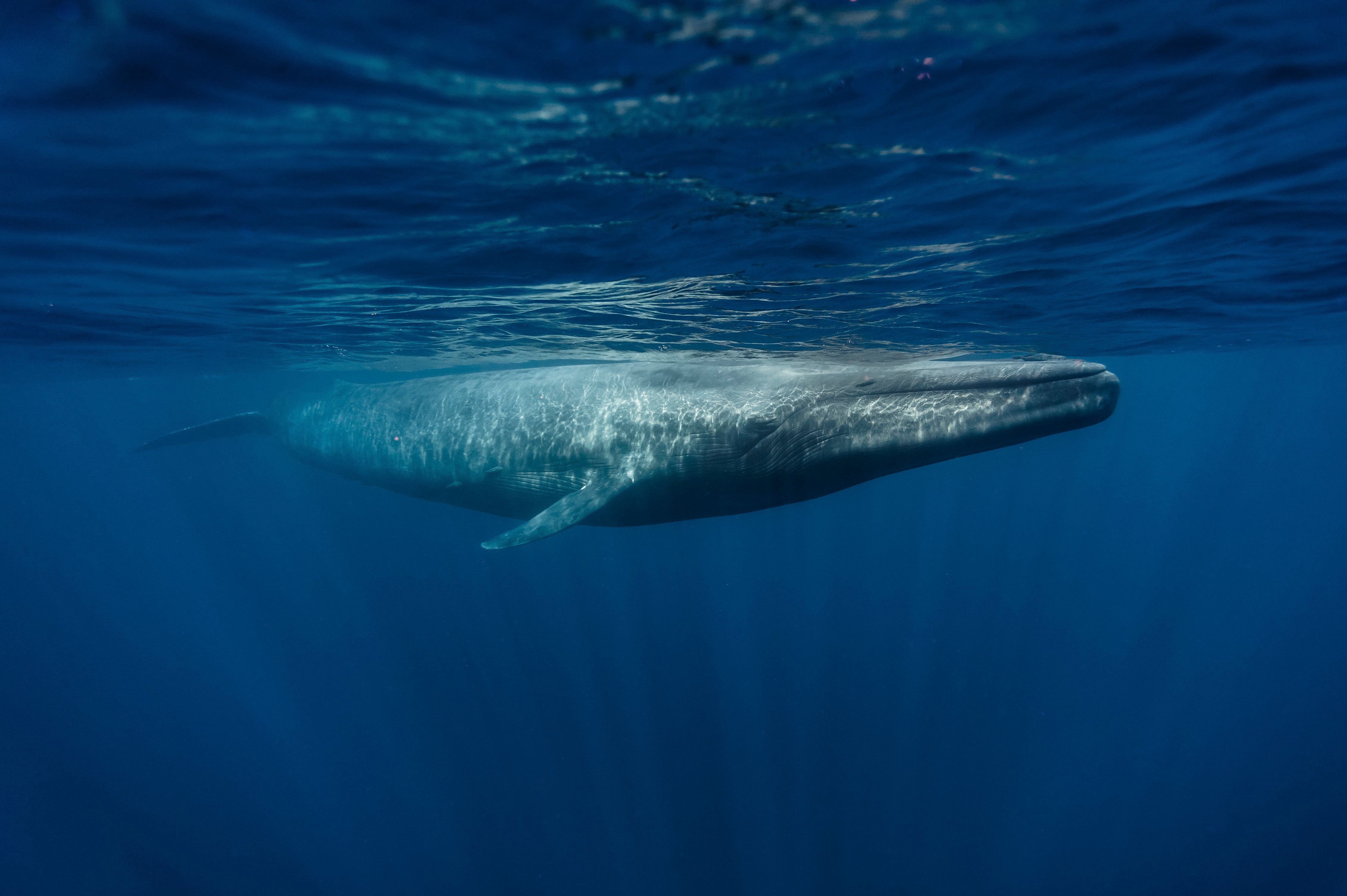
Whales were once an economic obsession. Oil rendered from their blubber—which lit the lamps and lubricated the machinery of the industrial era—fetched up to about $63 per gallon in today’s dollars in the mid-1800s. Whaling fleets killed blue, fin, humpback and sei whales by the hundreds of thousands. Blue whale populations plummeted by as much as 90 percent in the early to mid-20th century. As whales became scarce, the price of their oil soared, and the world turned to cheaper products as alternatives. Although whales today aren’t the coveted commodity they once were—and some species are recovering—they are still vulnerable to profit-driven industries, now through threats such as fishing net entanglements, ship strikes and pollution.
But these giant mammals may offer today’s economy a new kind of value: an ability to safely lock away climate-warming carbon and to support ecosystems that do so on an even bigger scale. Just one whale can support as much carbon storage as thousands of trees. A group of researchers, entrepreneurs and economists is betting that putting a price on whales again—this time to facilitate financial investment in their carbon-storing services—will help to both offset carbon emissions and protect the animals. “If you have a price of zero on something, then people take it for granted and completely abuse it,” says Connel Fullenkamp, a Duke University financial economist and co-founder of Blue Green Future, one of the organizations participating in this effort, called the Whale Carbon Plus Project.
The idea of pricing forests, coastal seagrass and other natural resources that absorb carbon and help fight the climate crisis—so that companies can invest in them to offset emissions—is gaining popularity. Consulting firm McKinsey & Company estimates that demand for carbon credits will grow 100-fold by 2050, and the Biden administration announced last year that it is working to standardize carbon credits and other natural asset valuations. But this approach is controversial.
There are few scientific data on the effectiveness of offsets and such nature-based solutions, but several journalistic investigations have shown that if offsetting programs are poorly designed or misused, they can have limited impact and can sometimes even be damaging. For instance, newly planted forests set aside for offsets have literally gone up in smoke during wildfires. This not only kills any hope of offsetting emissions but also pumps even more carbon dioxide into the atmosphere.
Unlike this type of land-based carbon storage, ocean and coastal ecosystems can lock away carbon for millennia. When marine life dies, it sinks to the bottom of the ocean, where its carbon is stored in extremely deep water. And carbon stored by vegetation in seafloor soils can’t enter the atmosphere as easily as carbon stored by plants at the surface. That makes investments in blue carbon—carbon stored in the ocean—appealing for offsetting projects. “Blue carbon is one of the closest things you’ll ever get to a true carbon offset,” says environmental scientist Peter Macreadie of Australia’s Deakin University, who is not involved in the Whale Carbon Plus Project. Though blue carbon projects often focus on coastal vegetation, the tiny phytoplankton that serve as the base of the ocean food web are among the biggest carbon sinks in the world. They absorb around 40 percent of the carbon dioxide produced globally each year—and whales aid that process because their nutrient-rich feces feed phytoplankton growth. Whales also store carbon in their massive body, which eventually sinks to the seafloor when they die.
Since 2018 a Canadian company called Whale Seeker has been training artificial intelligence algorithms to detect whales in satellite and aerial images. Its whale detection service is offered for sale to whale researchers, government agencies, nongovernmental organizations, Indigenous groups, and private shipping and mining companies monitoring their environmental impact. “We were already working with organizations that were regulated and mandated to monitor whales,” says Emily Charry Tissier, a co-founder of Whale Seeker, which is also part of the Whale Carbon Plus project. But existing measures intended to protect whales, such as ship speed limits, are often voluntary. Whale injuries are hard to track.
So Charry Tissier considered how the company’s whale detection data might be used to develop a new carbon credit program that would financially incentivize companies to protect whales.
She spoke with economists at Blue Green Future, whose founders, including Fullenkamp, had prior experience in assigning a financial value to parts of nature. In a 2019 report, they valued the average living great whale—a member of a group that encompasses the 13 largest whale species—at $2 million. That number came from adding the value of whales’ contributions to blue carbon storage and to the enhancement of fisheries through the nutrients in their feces to the roughly $2 billion in tourism revenue from whale watching. The amount of carbon a whale can sequester in its body was estimated using current data on the biomass of whole populations and on the amount by which whale feces increase phytoplankton numbers.
The ultimate goal of the Whale Carbon Plus Project is to have investors buy rights to whales’ carbon sequestration and other valuable natural services from the government, much like a bond, and receive interest in the form of carbon credits. Investors could then use the credits to offset their own carbon footprint or sell them to others to do the same. Income from such investments could be earmarked for Indigenous and local communities and for whale conservation groups. If a ship hits a whale, the government could fine the owner a monetary value commensurate with the loss. Fullenkamp suggests insurance companies might cover fines but require ships to carry whale detection equipment, which would further protect the animals. Whale Seeker’s methods could also help monitor whether industries are adhering to regulations—and could help audit carbon credit systems to see if they’re effective. “A lot of what’s missing with high-quality blue carbon is proof” that the program is working and actually sequestering carbon, Charry Tissier says.
Toward that end, Whale Seeker announced a pilot project this past summer to study how narwhals benefit ecosystems in the Canadian Arctic. The team has identified narwhals in four years’ worth of aerial images provided by the mining company Baffinland Iron Mines, which Charry Tissier says collects such photographs as part of permit requirements and its own commitment to operate sustainably. Canada’s Department of Fisheries and Oceans, another collaborator, is helping to fill gaps with ecological and oceanic data from its own research. The pilot project aims to assess where narwhals are living, how many there are and how they aid phytoplankton blooms.
Better data on how well carbon credit projects are working could help them succeed, says Adrienne Buller, director of research at the think tank Common Wealth and author of the book The Value of a Whale. But she warns that such projects can’t be seen as a way to avoid the work of actually scaling back emissions. “We’re relying on carbon offsets to allow our lives to remain broadly unchanged,” says Buller, who is not involved in the Whale Carbon Plus Project. Instead she contends that nature-based solutions might be a tool best saved for emissions that can’t be as easily reduced.
For some, unease about such projects runs deeper than the numbers—especially when it comes to intelligent animals such as whales. “It’s very understandable and hopefully common,” Buller says, “that there is an inherent ickiness to the idea of placing an abstract dollar value on complex life-forms.”
Fullenkamp notes that the Whale Carbon Plus Project is not advocating for the ownership of wild animals, only the services they provide. But he says that he understands the concerns and that those involved with the project are thinking through and trying to avoid all the potential pitfalls. “We need to be careful about what we do and how we approach the markets,” he says. Fullenkamp argues that philanthropists and governments cannot provide all the funds conservation efforts require. “The only social organization capable of providing that kind of money is the financial markets,” he says. Macreadie agrees. “The private sector needs to pick up the big gap in conservation,” he says.
But even some of those who are involved with the new project and who think it could be a valuable way to protect whales lament that it is necessary. “I wish we didn’t have to translate it into dollars and cents,” Charry Tissier says. “I want my daughter to be able to see a whale in the ocean when she’s an adult. That is the main thing that’s driving me.”







